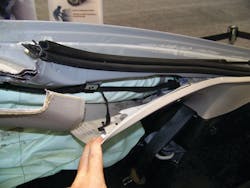SUBJECT: Electric Vehicles
TOPIC: Part 5, Chevrolet VOLT Extrication Procedures
OBJECTIVE: Given a crash scenario involving a 2011 Chevrolet VOLT with occupant injury and/or entrapment, the emergency responder will understand and be capable of accomplishing VOLT vehicle rescue and extrication tasks as appropriate.
TASK: Using an acquired junk vehicle for training, the rescue team shall study the information provided and practice extrication techniques as if the vehicle involved were a Chevrolet VOLT with injured and/or trapped occupants inside.
In Part 5, we continue our review of vehicle rescue and extrication tasks specific to the extended-range, plug-in electric Chevrolet VOLT. The rescue tasks discussed in this column focus on VOLT roof removal and interior entrapment situations typical of a hard-impact head-on collision scenario. The images are of the actual 2011 VOLT vehicle on which this author demonstrated extrication techniques during the 2010 Fire Rescue International conference in Chicago, IL.
Of the eight airbags on the Chevrolet VOLT, two are roof-mounted units. A deployed roof airbag will interfere with EMS personnel making patient contact. The bag can be cut away by responders to allow unobstructed access to the interior of the vehicle. When performing roof removal, the stored gas inflator for each airbag must first be located on the inside of the C-pillar by stripping the interior trim. It can be found on the rear pillar near the mounting location of the hatchback lifter strut.
The steel roof airbag inflator cylinder will have over 4,000-psi pressure inside it if the roof airbag is undeployed. A unique aspect with the VOLT roof airbag inflators is that once the interior trim has been stripped away in an effort to locate them, they will not be readily visible. The inflator unit is completely wrapped with the same nylon material that the airbag is constructed of. It is a bit challenging to locate this inflator.
In a frontal collision, responders may find that the front structure of the VOLT needs to be moved away from trapped occupants. In these situations, rescue personnel may find that they are required to move the dash and front instrument panel structure or deal with interior components such as seats or the steering wheel and column assembly.
In most cases, rescuers either jack the dash or roll the dash toward the front of the vehicle. The challenge with either of these tasks when attempted on a VOLT is that all the steel that you are dealing with is ultra-high-strength steel. Making any cuts in the A-pillar will require a power rescue cutter tool capable of cutting through these advanced steels. A reciprocating saw or an air chisel will not work. It will take a new generation of power cutter specifically designed for advanced steel.
Rolling the Dash
To roll the dash, if the roof has not already been removed, at least a six- or eight-inch section of the A-pillar will have to be cut out between the dash and the roofline. To weaken the A-pillar so it rolls, a horizontal cut will have to be made into the A-pillar below the bottom of the bottom door hinge. With the VOLT, make this cut go across the entire pillar as much as possible. It may be worth prying off the fender to expose the A-pillar and the upper rail to allow the pillar to be weakened by cutting.
The pushing tool used to roll the dash is generally a power ram. Follow standard procedures for placing the ram into position. As the tool pushes, the dash tie-down straps on each side of the center tunnel will disconnect from their mount on the top of the center tunnel. This releases the dash and allows good movement of the instrument-panel structure away from our patients.
When jacking the dash, again follow standard procedures. This time, make two parallel cuts into the A-pillar between the door hinges to create an opening. Open this notch by squeezing with a power spreader and bending the metal. Because of the unique crashworthy structural design of the VOLT, an additional cut can be made in the upper-rail structural area of the car, behind the top of the suspension strut tower. This cut will help the front structure to move as desired although this cut is not mandatory; it just helps if it is possible to be made. When working on the driver's side upper-rail area, you may encounter a small orange power cable near the vehicle's charging port. This orange power cable carries current only when the vehicle is plugged into a 120-volt or 240-volt charging station.
If rescuers must deal with interior components of the VOLT, it must be remembered that all four seats are individual seats due to the positioning of the high-voltage battery beneath the center tunnel area. The front two seats are bucket seats that slide on seat tracks and have adjustable position seatbacks. The two rear seats are individual fixed-position seats because the center tunnel runs between them. The seatbacks of these two rear seats fold forward, making a larger rear cargo area when needed.
The steering wheel ring consists of a U-shaped metal component wrapped with a soft outer covering. It is possible to cut away portions of the steering wheel ring with a cutting tool such as bolt cutters, reciprocating saw, or power cutter. With one cut, the steering wheel can be readily bent away from a patient if needed.
The steering column is a typical rack-and-pinion column with a tilt column adjustment feature. It is possible to cut through the steel center shaft of the column at the instrument panel using a power cutter or a reciprocating saw. The steel in the steering column shaft is typical of what is found on vehicles today.
Battery Shutdown
As mentioned in Part 3 of this series, the 360-volt lithium-ion battery shuts down when the VOLT's ignition is turned off, when any of the eight airbags deploy or when the 12-volt power is taken away. On top of the center tunnel and between the two front bucket seats is a center-console storage bin. Beneath this is a large orange plug. This safety device, called the Manual Service Disconnect, or MSD, is designed to be readily removed by responders if you want to be assured that all high-voltage current is isolated to just the lithium-ion battery.
TASK: Using an acquired junk vehicle for training, the rescue team shall study the information provided and practice extrication techniques as if the vehicle involved were a Chevrolet VOLT with injured and/or trapped occupants inside.
Read the rest of the series here:
RON MOORE, a Firehouse® contributing editor, is training chief for the McKinney, TX, Fire Department. He also authors a monthly online article in the Firehouse.com "MembersZone" and serves as the Forum Moderator for the extrication section of the Firehouse.com website. Moore can be contacted directly at [email protected].
About the Author
Ron Moore
RON MOORE, who is a Firehouse contributing editor, recently retired as a division chief with the McKinney, TX, Fire Department and now serves with Prosper, TX, Fire Rescue. He self-published the Vehicle Rescue 1-2-3 training manual and serves as the forum moderator for the extrication section of Firehouse.com . Moore can be contacted directly at [email protected].

